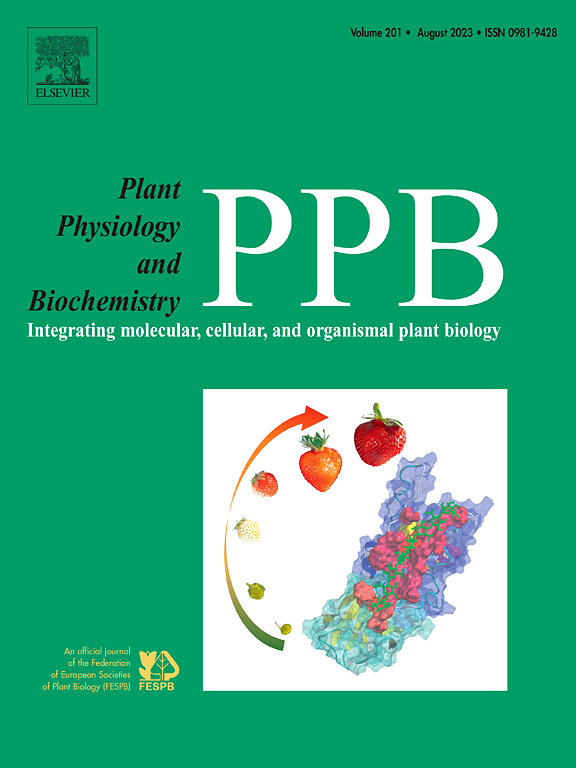异源过表达 Suaeda glauca 胁迫相关蛋白(SAP)家族基因可增强拟南芥转基因品系的耐盐性
IF 6.1
2区 生物学
Q1 PLANT SCIENCES
引用次数: 0
摘要
以锌指结构域为特征的应激相关蛋白(Stress-associated protein, SAPs)在调控植物对各种胁迫的反应中起着重要作用。这些蛋白调节与应激相关的基因表达,是增强植物免疫、发育、细胞增殖和激素调节的组成部分。在这项研究中,我们对青花Suaeda glauca (S. glauca)的SAP基因家族进行了全基因组分析,鉴定出15个编码A20/AN1锌指蛋白的SAP基因。对三个候选基因在盐胁迫下的功能进行了分析,检查了表型和生理反应,以更好地了解它们在胁迫耐受中的作用。序列比对、保守结构域分析和基因结构分析表明,青花水杉SAPs具有较高的保守性。系统发育分析确定了基因家族中的两个主要群体,为它们的进化关系提供了见解。转录谱分析显示,大多数SAP基因在盐胁迫下显著表达,qPCR验证证实了特定基因的上调。值得注意的是,异源过表达候选基因SgSAP4、SgSAP5和SgSAP7的转基因拟南芥株系对盐胁迫的耐受性增强。与野生型植物相比,这一点从改善种子发芽、根伸长和降低胁迫标志物(包括丙二醛和游离脯氨酸)水平可以明显看出。这些发现突出了这些SAP基因在旨在提高作物耐盐性的育种计划中的潜力。本文章由计算机程序翻译,如有差异,请以英文原文为准。
Heterologous overexpression of the Suaeda glauca stress-associated protein (SAP) family genes enhanced salt tolerance in Arabidopsis transgenic lines
Stress-associated proteins (SAPs), characterized by zinc finger domains, play a crucial role in regulating plant responses to various stresses. These proteins modulate stress-related gene expression and are integral to enhancing plant immunity, development, cell proliferation, and hormone regulation. In this study, we conducted a genome-wide analysis of the SAP gene family in Suaeda glauca (S. glauca), identifying 15 SAP genes encoding A20/AN1 zinc finger proteins. Functional analyses of three candidate genes under salinity stress were performed, examining phenotypic and physiological responses to better understand their role in stress tolerance. Sequence alignment, conserved domain analysis, and gene structure analysis revealed high conservation among S. glauca SAPs. Phylogenetic analysis identified two major groups within the gene family, providing insights into their evolutionary relationships. Transcription profiling analysis demonstrated significant expression of most SAP genes in response to salt stress, with qPCR validation confirming the upregulation of specific genes. Notably, transgenic Arabidopsis lines heterologously overexpressing the candidate genes SgSAP4, SgSAP5, and SgSAP7 demonstrated enhanced tolerance to salinity stress. This was evident from improved seed germination, root elongation, and reduced levels of stress markers, including malondialdehyde and free proline, compared to wild-type plants. These findings highlight the potential of these SAP genes in breeding programs aimed at improving salinity tolerance in crops.
求助全文
通过发布文献求助,成功后即可免费获取论文全文。
去求助
来源期刊
CiteScore
11.10
自引率
3.10%
发文量
410
审稿时长
33 days
期刊介绍:
Plant Physiology and Biochemistry publishes original theoretical, experimental and technical contributions in the various fields of plant physiology (biochemistry, physiology, structure, genetics, plant-microbe interactions, etc.) at diverse levels of integration (molecular, subcellular, cellular, organ, whole plant, environmental). Opinions expressed in the journal are the sole responsibility of the authors and publication does not imply the editors'' agreement.
Manuscripts describing molecular-genetic and/or gene expression data that are not integrated with biochemical analysis and/or actual measurements of plant physiological processes are not suitable for PPB. Also "Omics" studies (transcriptomics, proteomics, metabolomics, etc.) reporting descriptive analysis without an element of functional validation assays, will not be considered. Similarly, applied agronomic or phytochemical studies that generate no new, fundamental insights in plant physiological and/or biochemical processes are not suitable for publication in PPB.
Plant Physiology and Biochemistry publishes several types of articles: Reviews, Papers and Short Papers. Articles for Reviews are either invited by the editor or proposed by the authors for the editor''s prior agreement. Reviews should not exceed 40 typewritten pages and Short Papers no more than approximately 8 typewritten pages. The fundamental character of Plant Physiology and Biochemistry remains that of a journal for original results.

 求助内容:
求助内容: 应助结果提醒方式:
应助结果提醒方式:


